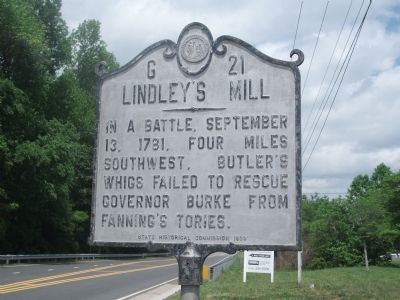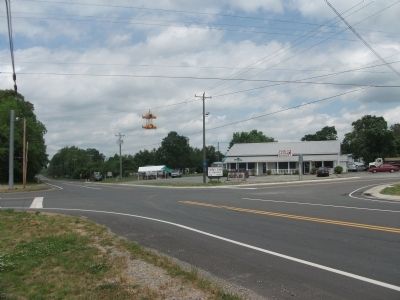Graham in Alamance County, North Carolina — The American South (South Atlantic)
Lindley's Mill
Erected 1939 by State Historical Commission. (Marker Number G-21.)
Topics and series. This historical marker is listed in these topic lists: Patriots & Patriotism • War, US Revolutionary. In addition, it is included in the North Carolina Division of Archives and History series list. A significant historical date for this entry is September 13, 1863.
Location. 35° 54.442′ N, 79° 18.452′ W. Marker is in Graham, North Carolina, in Alamance County. Marker is on North Carolina 87 near East Greensboro-Chapel Hill Road, on the left when traveling south. Touch for map. Marker is at or near this postal address: 7556 NC-87, Graham NC 27253, United States of America. Touch for directions.
Other nearby markers. At least 8 other markers are within 3 miles of this marker, measured as the crow flies. Uncle Eli's Quilting Party (approx. 0.4 miles away); Ernest Peter Dixon (approx. one mile away); The Battle of Lindley's Mill Memorial (approx. 1.1 miles away); Spring Friends Meeting (approx. 1.1 miles away); General John Butler (approx. 2.4 miles away); The Battle of Lindley's Mill (approx. 2.4 miles away); September 13, 1781 (approx. 2.4 miles away); Saxapahaw (approx. 2.4 miles away).
Regarding Lindley's Mill. Lindley's Mill was a gristmill built in 1755 by Thomas Lindley, an Irish immigrant. The mill is in operation today and owned by a descendant of Thomas Lindley. Flour is available at the mill and sold at select local stores.
The Battle of Lindley's Mill, also known as the Battle of Cane Creek, was fought September 13, 1781. It was the largest engagement of North Carolina’s “Tory War” and was fought near Thomas Lindley’s mill on Cane Creek.
Loyalist Colonel David Fanning, leader of the Loyalist militia in central North Carolina, had received approval from British authorities in Wilmington to attack the state capital at Hillsborough. With nearly 700 men, he advanced on Hillsborough, in Orange County, NC. He attacked at dawn on September 12, 1781, taking advantage of a heavy fog. Sleeping Hillsborough was taken by surprise and 200 prisoners were captured, including most of the General Assembly and Governor Thomas Burke.
After their victory, Fanning and his men, left for Wilmington with their prisoners.
News of the battle reached Brigadier General John Butler of the North Carolina militia that evening. Butler, who had led North Carolina militia at Guilford Courthouse, quickly organized men from Orange County to intercept the Tory force.
Butler’s men, numbering approximately 400, arrived ahead of Fanning at Lindley’s Mill, near a ford across Cane Creek on a plateau overlooking Stafford’s Branch.
On the morning of September 13, as the Loyalists crossed, the militia fired a musket volley from the tree line on the opposite bank tore into their ranks.
The Loyalists charged toward the Whig position, Colonel McNeil was among the first shot and killed.
Fanning ordered the prisoners to be sheltered in the Spring Friends Meeting House in the rear of the battle. Although outnumbered, the Whigs advanced, pressing the head of the Tory column back toward the chapel. Their goal was probably to free Burke and the other prisoners.
Fanning then organized an assault that flanked Butler’s men, threatening to surround his forces. Just as he began driving Butler’s men from the field, Fanning received a serious wound in his arm. He left the forces in McDougald’s command and retired from the field of battle.
Butler's men, outnumbered and outmaneuvered, retreated. Fanning’s column continued on to Wilmington with the prisoners.
That night, local Quakers collected the dead and wounded on the field. Whig casualties consisted of 25 killed, 90 wounded and 10 captured. Tories lost 27 killed and 90 wounded.
Surgeons from the surrounding countryside were called upon to care for the wounded.
One of these surgeons was Dr. John Pyle, who earlier that year had led his Loyalist militia regiment into an ambush at Pyle’s Defeat. Putting aside his earlier allegiances, Pyle worked tirelessly for the injured of both sides. In return, Governor Alexander Martin pardoned him at war’s end.
Portions of remarks courtesy of North Carolina Department of Cultural Resources, North Carolina Highway Historical Marker Program.
Additional keywords. Battle of Cane Creek, Graham, Mebane, Mebanesville, Hillsboro, American Revolutionary War, Regulators, Hillsborough
Credits. This page was last revised on May 11, 2023. It was originally submitted on May 1, 2010, by Paul Jordan of Burlington, N. C., U. S. A.. This page has been viewed 3,023 times since then and 66 times this year. Last updated on May 9, 2023, by Michael Buckner of Durham, North Carolina. Photos: 1, 2. submitted on May 1, 2010, by Paul Jordan of Burlington, N. C., U. S. A.. • J. Makali Bruton was the editor who published this page.

